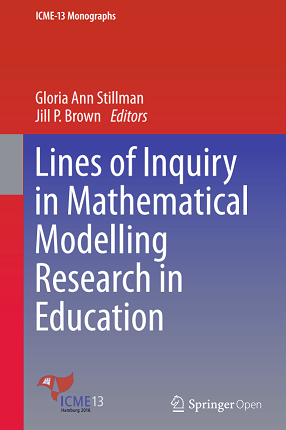
e-BOOK
Lines of Inquiry in Mathematical Modelling Research in Education
This essential interrelationship between the real world and mathematics has been recognised by many in education and educational research as of critical importance and has given rise to a sub-field of educational research related to the teaching and learning of mathematical applications and mathematical modelling. Arguments continue as to the importance and placement of modelling and applications in school mathematics. The chapters in this book generally follow the view that even
young students should be challenged to solve real-world problems. Across the levels of schooling and into tertiary, modellers will use the mathematical knowledge and tools they have at their disposal to solve a given problem. Such engagement with real problems will motivate students to learn mathematics and appreciate its usefulness and importance. Through solving real-world problems,
students will come to appreciate the importance of simplifying the complex and messy real world. This simplification in order to find a first solution, which is then validated and revisited with added complexity, will support the same approach in pure mathematics problems. The use of collaborative groups, and the subsequent interthinking to solve real-world problems, enhances student engagement with mathematics and increases the capacity of students to solve tasks.
However, society, in general, still too often holds mathematics in low esteem and this in turn impacts on how mathematics is taught and learnt from the early years through schooling and in universities and other tertiary educational institutions. Applications continue to have a presence in mathematics curricula. In application tasks, the task setter begins with the mathematics and determines a real situation
where this mathematics is used. For example, with a focus on volume, an application might be how many trips with a given sized truck are needed to transport
cartons of given dimensions. With a focus on quadratic functions, an application is the trajectory of a cricket ball when hit for a six. Alternatively, in modelling tasks, the task setter begins with reality then looks to the mathematics that might be useful and then returns to reality to determine if the mathematical model or subsequent analysis actually answers the real-world problem. Task solvers may find an alternative approach or use different mathematics but are still expected to take the real
world into account as being critical to the solution. They will discover, over time, that some mathematical solutions are not, in fact real-world solutions. Sadly, some students only ever experience application tasks during their school mathematics experiences or are not given the opportunity to become independent modellers able to solve real-world problems that interest them.
Ketersediaan
| 043 | 507 | Website | Tersedia |
Informasi Detail
- Judul Seri
-
-
- No. Panggil
-
507
- Penerbit
- Switzerland : Springer., 2019
- Deskripsi Fisik
-
x, 259 hlm.
- Bahasa
-
Inggris
- ISBN/ISSN
-
978-3-030-14931-4
- Klasifikasi
-
507
- Tipe Isi
-
-
- Tipe Media
-
-
- Tipe Pembawa
-
-
- Edisi
-
-
- Subjek
- Info Detail Spesifik
-
-
- Pernyataan Tanggungjawab
-
Gloria Ann Stillman
Versi lain/terkait
Tidak tersedia versi lain
Lampiran Berkas
Komentar
Anda harus login sebelum memberikan komentar
 Karya Umum
Karya Umum  Filsafat
Filsafat  Agama
Agama  Ilmu-ilmu Sosial
Ilmu-ilmu Sosial  Bahasa
Bahasa  Ilmu-ilmu Murni
Ilmu-ilmu Murni  Ilmu-ilmu Terapan
Ilmu-ilmu Terapan  Kesenian, Hiburan, dan Olahraga
Kesenian, Hiburan, dan Olahraga  Kesusastraan
Kesusastraan  Geografi dan Sejarah
Geografi dan Sejarah